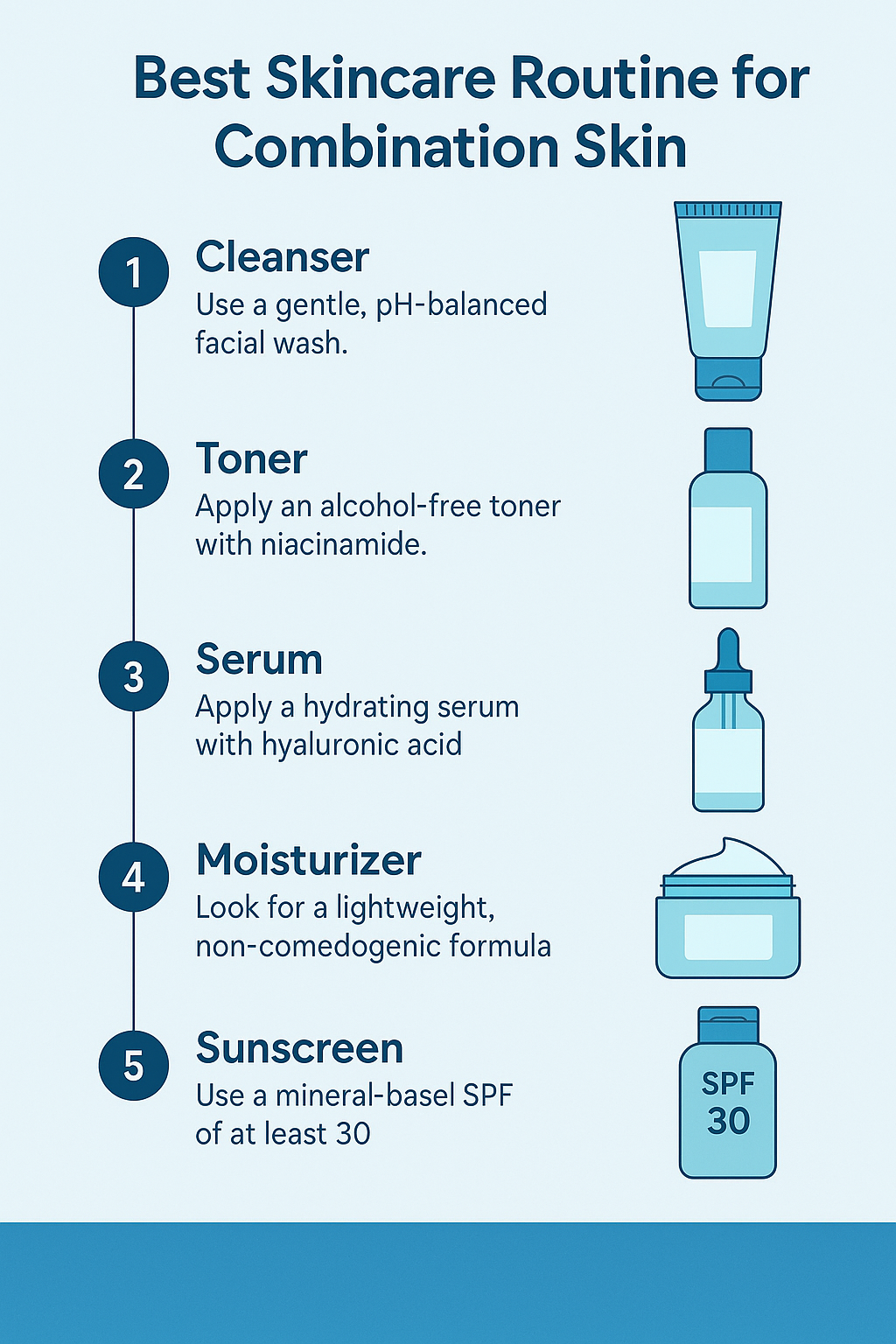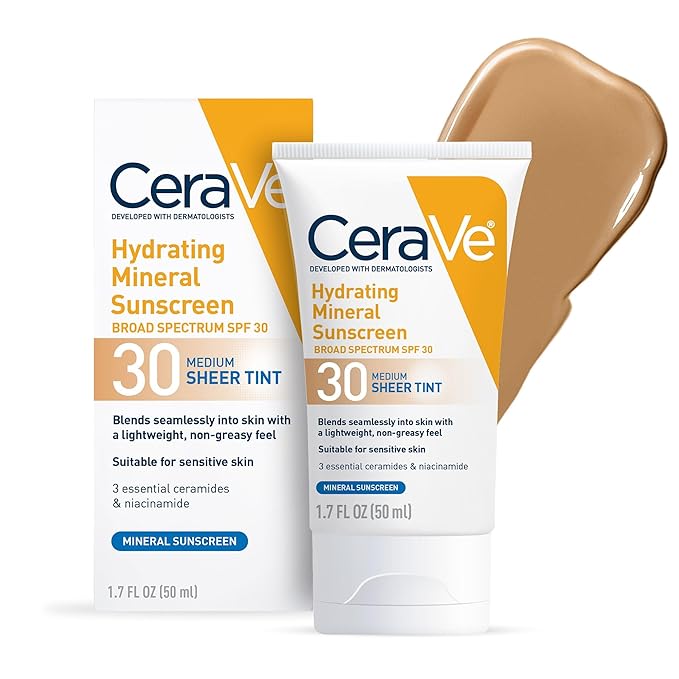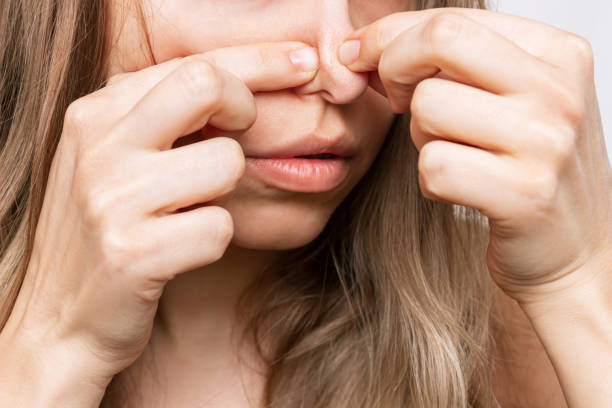Finding the best skincare routine for combination skin can be tricky. This skin type struggles with both oily and dry areas — typically an oily T-zone and drier cheeks. In this guide, we’ll walk you through a balanced, dermatologist-backed routine for combination skin, including product picks and expert tips to help you achieve clear, healthy skin.

What is Combination Skin?
Combination skin has areas that are oily as well as dry. The sebaceous glands in the T-zone are producing more oil than necessary, while other areas may become dry because of lower lipid production. According to a study, the imbalance in sebum production can be influenced by both genetic and environmental factors
Signs of Combination Skin
Typically, an Oily T-zone with noticeable pores (forehead, nose, chin)
Dry or normal cheeks with tightness or flaking
Occasional breakouts in the oily areas
Makeup usually wears off quickly in the T-zone, but is flaky on the cheeks
Sensitive to weather changes (more oily in summer, drier in winter)

Common Causes of Combination Skin and How to Treat It
So, what causes combination skin? Several common causes of combination skin include:
Hormones: Changes in hormones can increase sebum production in the T-zone. Therefore, many people with hormonal changes experience breakouts in this area.
Genetics: If your parents have combination skin, then you are more likely to have it too.
Environmental: Exposure to pollution, humidity, and temperature swings can all lead to combination skin. For example, cold weather may dry out the cheeks while heat increases oiliness in the T-zone.
How to Test for Combination Skin at Home: Find the Best Skincare Routine
Wash Your Face – Use a gentle cleanser and wash your face. Skin should be patted dry, and do not use any skincare products on your skin.
Wait 30 minutes – Allow the skin time to “rest” without anything on it so you can see its natural state. Check Your Skin- Look if there is shine, dry flaking, or oiliness in the areas below:
Oily T-zone (forehead, nose, chin)
Dry/Clear Cheeks -> Probably Combination Skin.
Blotting Paper Test
Use separate blotting papers on different parts of your skin.
A blotting paper is oily on the T-zone (forehead, nose, and chin) and dry/normal on the cheeks?
The moisture test confirms combination skin! Confirm By Product Application
Apply a light-weight moisturizer in a product you know and observe if it absorbs, feels greasy/dry on different parts of your face.
Some areas absorb quickly, and some stay greasy, hence it has combination skin.
Once you see the mixed oil and dry patterns, you can conclude you have combination skin!
Step-by-Step Combination Skin Care Routine (Backed by Science)
AM Skincare Routine
Cleanser: Choose a gentle, pH-balanced facial wash that will remove excess oils while avoiding stripping the moisture from the skin.
🔹 Best Products: La Roche-Posay Toleriane Hydrating Gentle Cleanser (UK) | CeraVe Foaming Facial Cleanser (USA)
Toner: Use an alcohol-free toner that contains niacinamide to restore balance.
🔹 Best Product: Paula’s Choice Pore-Reducing Toner (UK & USA)Serum: Apply a hydrating serum that contains hyaluronic acid and niacinamide.
🔹 Best Product: The Ordinary Niacinamide 10% Zinc 1%
Moisturizer: Look for a non-comedogenic, lightweight moisturizer.
🔹 Best Product: Neutrogena Hydro Boost Gel Cream (UK) | CeraVe PM Facial Moisturizing Lotion (USA)
Sunscreen: Protect against UVA and UVB with a mineral-based SPF.
🔹 Best Product: Ultra Violette Clean Screen SPF 30 (UK) | EltaMD UV Clear SPF 46 (USA)
PM Skincare Routine
Cleanser: First, complete a double cleanse using an oil-based cleanser followed by a gentle face wash.
Toner: Rebalance while ensuring hydration with a hydrating toner.
Treatment: Apply a targeted treatment, such as a form of azelaic acid, to control oil levels and hydrate – azelaic acid can reduce the potential for any clogged pores.
🔹 Best: Paula’s Choice 10% Azelaic Acid Booster.
Moisturizer: Use a night cream that is slightly richer and contains ceramides as its primary ingredient.
Optional sleeping mask: Apply a sleeping mask to amp up hydration.
Natural Skincare Routine for Combination Skin (Backed by Science)
Cleansing: Raw honey very gently cleanses and balances skin.
Toning: Green tea extract reduces oil production and calms dry skin.
Serum: Aloe vera gel hydrates and heals skin while reducing redness.
Moisturizing: Rosehip oil nourishes dry areas without clogging.
Masking: Oatmeal masks strengthen the skin barrier and calm skin irritation.
Sunscreen Alternative: Raspberry seed oil gives some mild UV protection; it is not a replacement for sunscreen.
DIY Natural Skincare Recipes for Combination Skin
Soothing Honey & Oatmeal Cleanser
1 tbsp raw honey
1 tbsp finely ground oatmeal
One tsp rose water
Instructions: Combine the ingredients, apply to damp skin, massage the formula gently into skin, and then rinse with lukewarm water
Balancing Green Tea & Aloe Vera Toner
½ cup brewed green tea (cooled)
1 tbsp aloe vera gel
Instructions: Combine the ingredients, place in a spray bottle, and spritz this refreshing toner on your skin throughout the day.
Hydrating Avocado & Yogurt Mask(will give skin a beautiful glow)
½ ripe avocado
1 tbsp plain yogurt
1 tsp honey
Instructions: Mash the avocado in a bowl. Once mashed, mix with the yogurt and honey, apply to face for a minimum of 15 minutes, then rinse with water and enjoy your new glow.
Mistakes to Avoid in Your Combination Skin Care Routine
Using harsh cleansers that strip natural oils
Skipping moisturizer (oily areas still need hydration!)
Over-exfoliating, which worsens oil production
Applying heavy creams that clog pores
Not adjusting skincare for seasonal changes
Ingredients to Avoid & Best Ingredients for Combination Skin
Ingredients to Avoid
- Alcohol-based toners (drying)
- Sulfates (strip natural oils)
- Heavy oils like coconut oil (clog pores)
- Synthetic fragrances (can irritate)
Best Ingredients for Combination Skin
| Ingredient | Benefit |
| Hyaluronic Acid | Hydrates without greasiness |
| Niacinamide | Balances oil production |
| Ceramides | Strengthens the skin barrier |
| Green Tea Extract | Controls sebum, reduces redness |
| Azelaic Acid | Reduces oiliness and breakouts |
| Squalane | Lightweight hydration |
Final Thoughts: Achieving Balanced, Healthy Skin
For those with combination skin, the goal is to hydrate areas that tend to feel dry while being diligent about the areas that tend to be oily across the T-zone. Use skin-friendly products with proven science to build a skincare routine designed for your skin needs, and you’ll have healthy glowing skin. This guide is designed to provide research-backed recommendations from skin experts. Follow a daily routine, adjust for seasonal changes, and highlight hydration and sun protection for your best skin health!
Best Tinted Mineral Sunscreens for Acne-Prone & Sensitive Skin (UK & USA)
If you have acne-prone or sensitive skin, finding a sunscreen that protects without causing breakouts…
AI Personalized Skincare: Future Routines for UK & USA
Have you ever felt lost in the endless aisles of skincare products, wondering which one…
How to Get Rid of Blackheads Fast at Home
Blackheads can be disappointing, especially when cleaning your skin quickly before a big day or…
How to Get Rid of Blackheads: 7 Proven Steps for Clear, Healthy Skin
Blackheads – Tiny dark spots caused by clogged pores – are a universal skincare concern. “Blackhead removal,” “How…
Glass Skin Routine for Dry Skin UK | Hydrated, Radiant Skin
Achieving glass skin for dry skin in the UK can feel impossible with the cold,…
Summer Skincare Guide: Prevent Sun Damage & Breakouts
As the days grow longer and the sun shines brighter across the UK and the…
Discover more from The Healthcare Diary
Subscribe to get the latest posts sent to your email.






Pingback: Daily Skincare Routine: The Ultimate Guide for Glowing Skin - The Healthcare Diary